Forget Unbound – Gravel Burn is the toughest off-road stage race in the world and this is why it needs to be on your bucket list
Mecurial weather. Unforgiving terrain. Sensational scenery. Gravel riding like nothing else. This is Africa, this is Gravel Burn
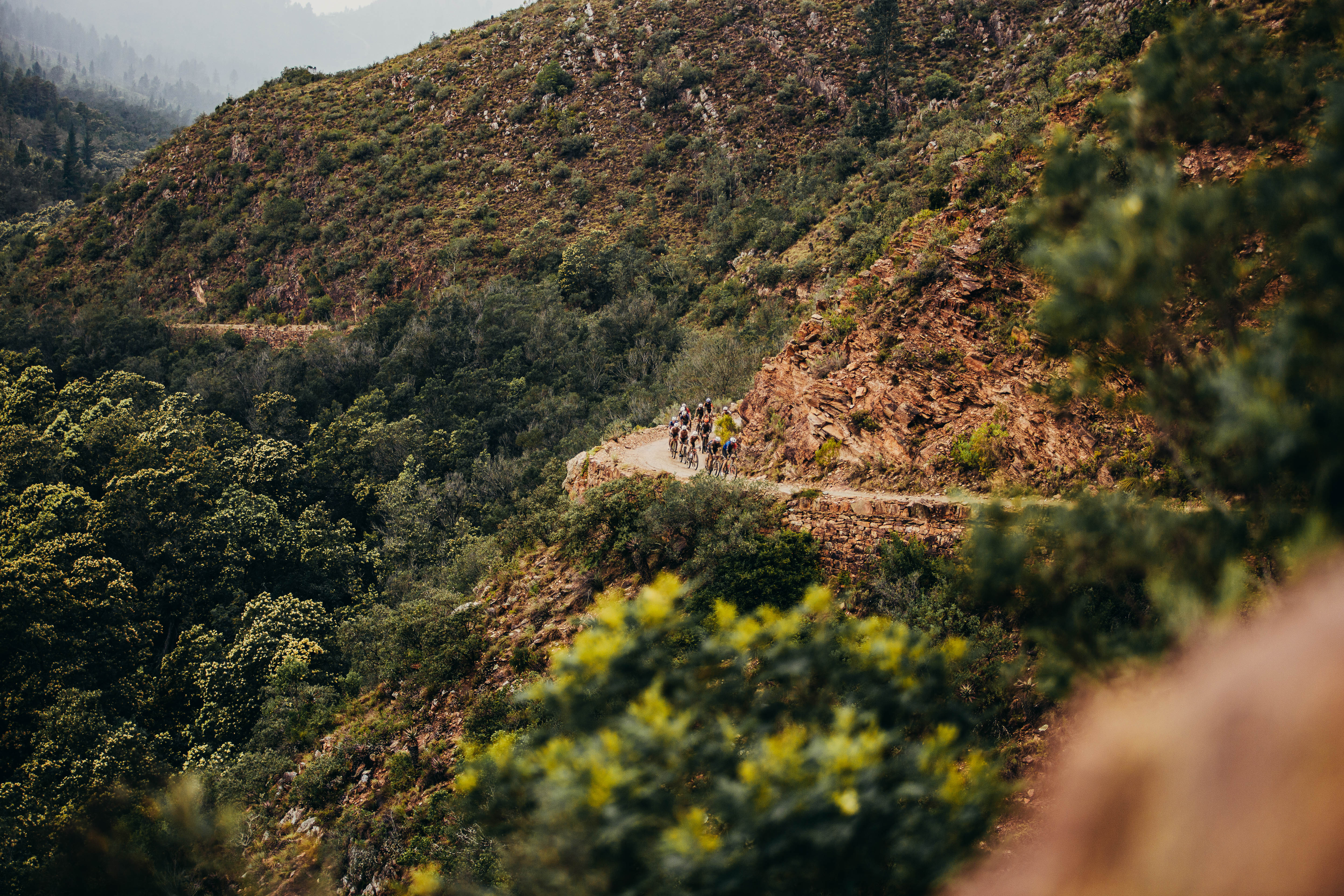
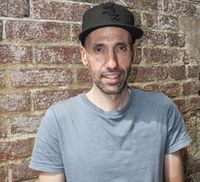
I thought I was prepared for Gravel Burn. I mean, I was – I did all the training and was in good shape going into the race, but I think I just underestimated everything about South Africa, particularly the region and the terrain I traversed during the seven stages. It was extremely hard on the body – particularly the hands, shoulders, neck, and arms. Perhaps I made the wrong equipment choices, but with so many external factors influencing the seven stages, it was impossible to predict an accurate outcome. It’s a beautiful race but also unforgiving. It takes no prisoners, and the moment you show any weakness, it will chew you up and spit you out.
And before you ask, yes, I’m a South African, but I've been living in the UK for the past six or seven years. I’ve raced most of the mountain bike stage races in South Africa, including the Cape Epic, and am well-versed in the terrain's unpredictability.
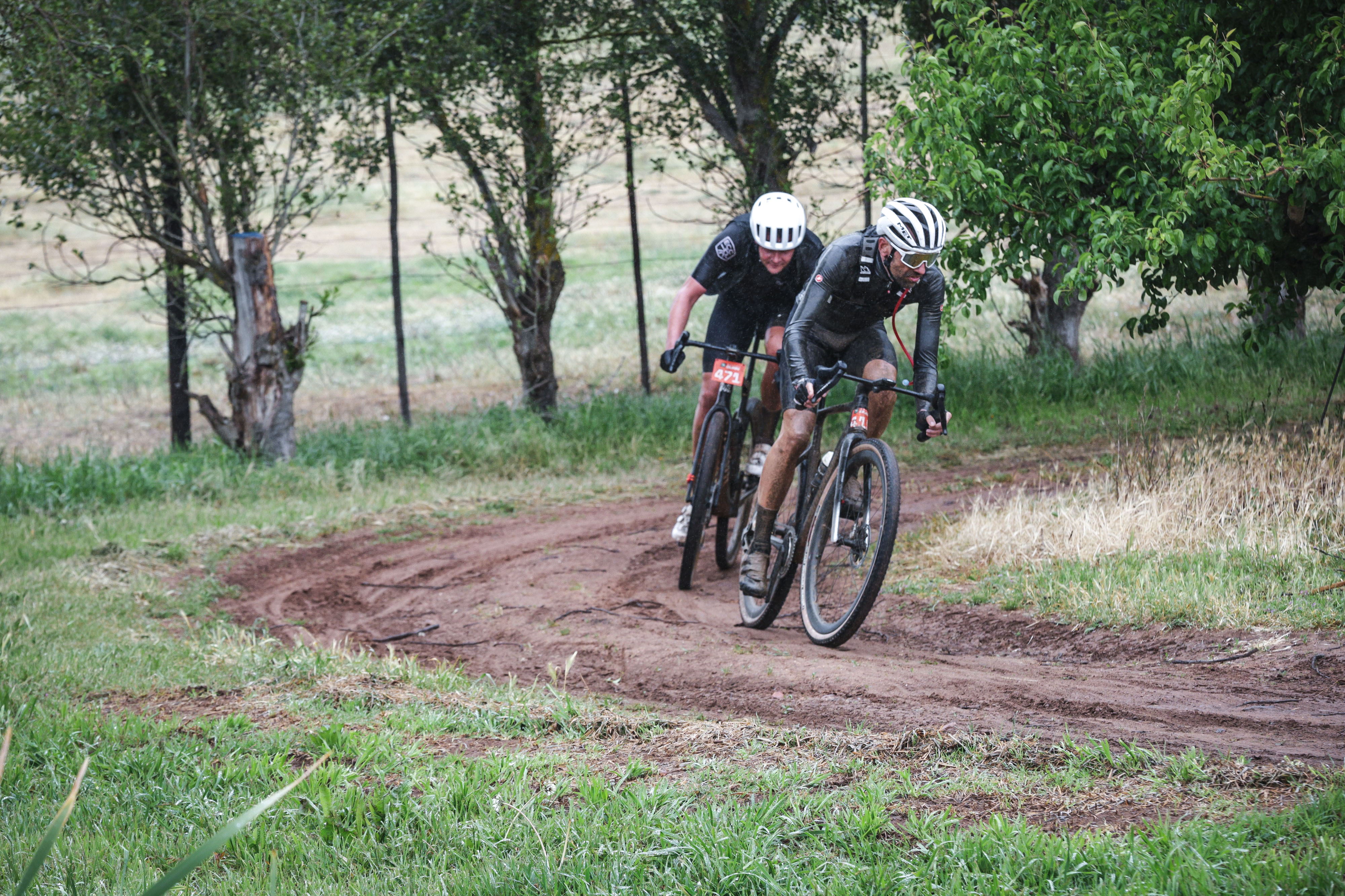
A rare patch of no rain at the finish of Stage 1 of Gravel Burn in Avontuur
I, along with many other riders, didn't expect what was on the menu in terms of technical terrain – this was dubbed a gravel bike race after all, but, at the same time, this is Africa, and it was perhaps naive of me to expect anything less. While I knew 'champagne gravel' is a loose term in this setting, I didn't expect as many corrugations and washboard surfaces, and would have probably looked at fitting wider tyres or a suspension fork in retrospect. I wrote about my equipment and gravel bike in depth, leading up to and after the race – you can read all about my Cannondale SuperX Lab71 setup and what worked and what didn’t.
One thing the UK has taught me, however, is to prepare for all kinds of weather, and I thankfully packed the right kit for all eventualities. This is probably a good time to talk you through the weather we experienced over the seven days.
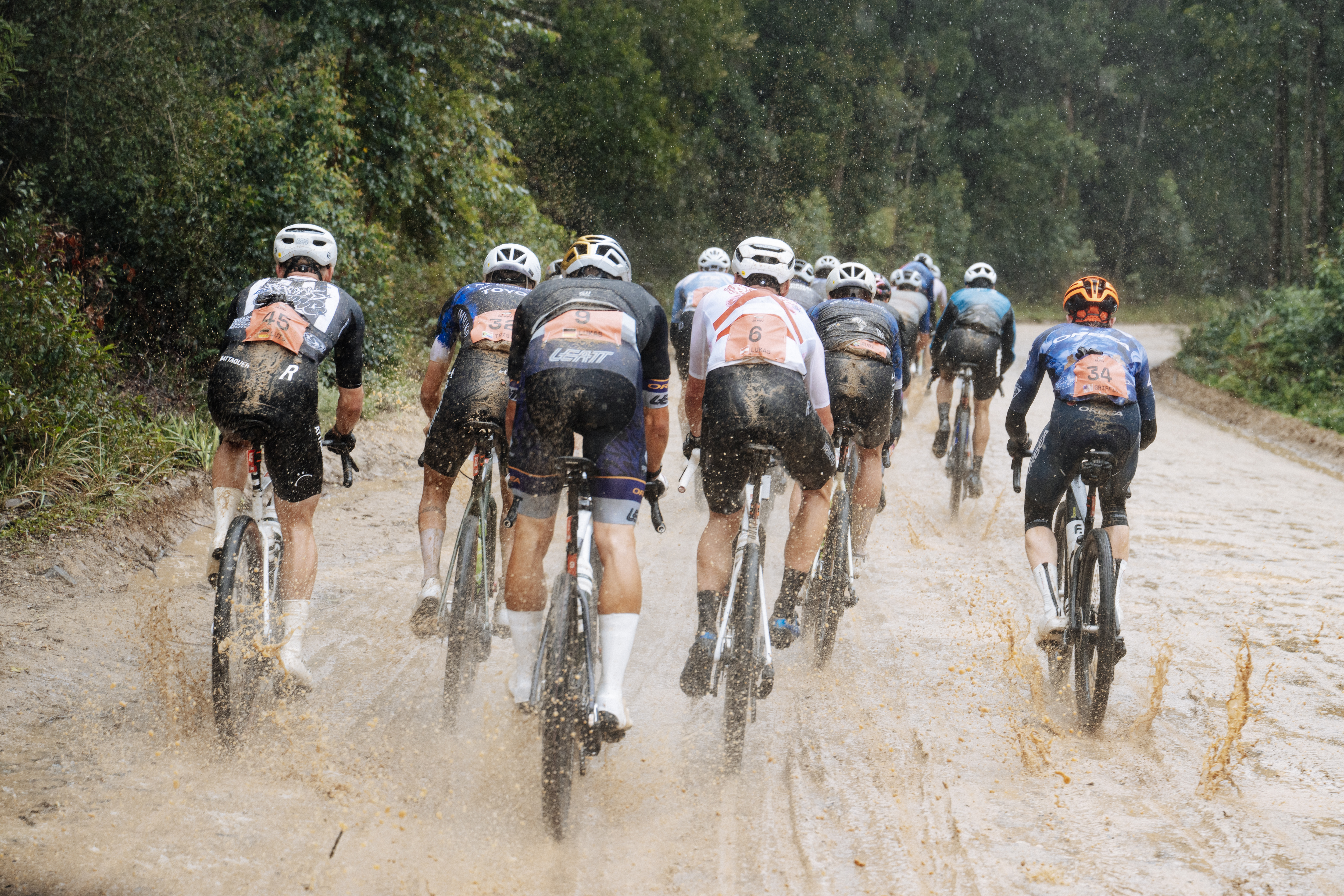
Rain and mud played on repeat for practically the whole stage
I bless the rains down in Africa
Simon Pellaud best described the weather leading up to the race start in Knsyna at the pro rider press conference.
“They told me, come to South Africa, it’s summer and you'll have beautiful weather. It’s beautiful, yeah, but it looks like Belgium in March.”
Simon wasn't lying. It was super wet with biblical rain pouring down for 48 hours. This made for a testing Stage 1 and questioned the mental strength of riders. It wasn't going to be an easy day, even in perfect conditions.
We all knew we just needed to get on with it and race the 83km/2,200m route to Avontuur. The rain didn't stop, and the conditions were treacherous once we hit the gravel roads at the top of the Simola climb. It was slippery but achingly beautiful – forest roads morphed into mountain passes and fast, flowing descents. You’d get hot, then cold, and then hot again, but my Castelli Gabba R long sleeve jersey worked a treat – it kept me dry and warm for the entire stage. The Prince Alfred Pass was extraordinary. At 13km long, it was challenging, but rewarding at the same time. It would get even colder as the night closed in.

Riders had to get creative to dry their clothes and shoes, using the camp fire
Drenched from the stage, riders used the campfires to dry their clothes and shoes, but didn't expect sub-zero temperatures to close in. Negative figures came for us during the night, freezing our tents, clothes, and shoes left outside; even our bicycles were frozen solid. That said, we were at nearly 1,000m above sea level.
The latest race content, interviews, features, reviews and expert buying guides, direct to your inbox!

We awoke to negative temperatures on Stage 2 and frost and ice on our tents and bikes
We awoke to -3 degrees on the morning of Stage 2, but by the afternoon, the mercury had inched into the thirties – a massive swing in temperature. There was some wind on Stage 2, but it was generally an enjoyable day as we moved from the Western Cape into the Eastern Cape. A mix of technical climbing, descending, and fast gravel boosted our mental health, but the toughest days were yet to come.
Stage 3 was a shock to the system, featuring some technical climbs and our first taste of loose, rocky terrain, which mangled many wheels and destroyed tyres. I suffered my first puncture of the race here, tearing my sidewall and needing a completely new tyre fitted at the next aid station. I lost time, but thankfully I was in better shape than gravel pro Peter Stetina, who told me he destroyed his wheel and tyre after smashing a rock and had to ride on the rim for 10km. All things considered, nothing could prepare the field for what Stages 4-7 had in store.
Stage 4 featured the race's only loop, with 111km and 1,500m on the cards. It wasn't so much the altitude and temperature but rather the first taste of rough terrain that tested our mettle. Corrugations? Sure, that was standard, but the choppy, loose and rocky descents were hard on the body. This was the first stage where I experienced a bit of 'hot foot' (a painful, burning and numbing pain under the ball of the foot caused by nerve compression). I soldiered on and kept momentum as swiftly as I could, trying to drive it hard down the bumpy descents and make up time on the inclines. A hard, well-earned stage left me questioning my life choices, but I was also excited about the following day's mountain-top finish.

While hostile and unforgiving in many ways, we were treated to some sensational scenery over the week of racing
Stage 5 was a race of two halves. The start served up 10km of gravel before 80km of smooth tarmac provided some relief for our aching bodies. It wasn't a walk in the park, as the sharp end of the racing age groupers made it hard, sending echelons across the road and splintering the group as we crested the first climb. This caused a split and a 20-30 man selection, which I managed to make. A long and fast descent followed, and gave way to spectacular views and scenery before we made our way onto a brutal section of gravel, where the racing officially kicked off. The group was shattered with bodies everywhere. With temperatures soaring, the final challenge and mountain top finish lay in wait – an 18km climb up the Swaershoek Pass. Tom Pidcock won the stage, but there were battles further down, too. It wasn't the gradient so much as the heat that made it super tough, with temperatures well over 35 degrees recorded on the climb. A 4km neutral descent to the camp felt even harder; the bumpy surfaces and vibrations rattled me to the core. I barely had any strength left to grip the bars. The hardest stage was yet to come...
A storm came in during the evening with strong, gale-force winds blowing down the nearby bergs into our campsite in Merino Farm at 1,300m above sea level. The wind blew savagely during the night, pummeling the camp and suckerpunching our tents without relenting. I'm not sure many riders managed any sleep that night; I know I didn't. The wind worsened in the morning, reaching dangerously close to 100km/h at times, eventually blowing down the dining marquees and ravaging the tented villages. With the storm yet to arrive, the organisers decided to delay the start of the stage, as no evacuation or detour was possible due to our remote location.
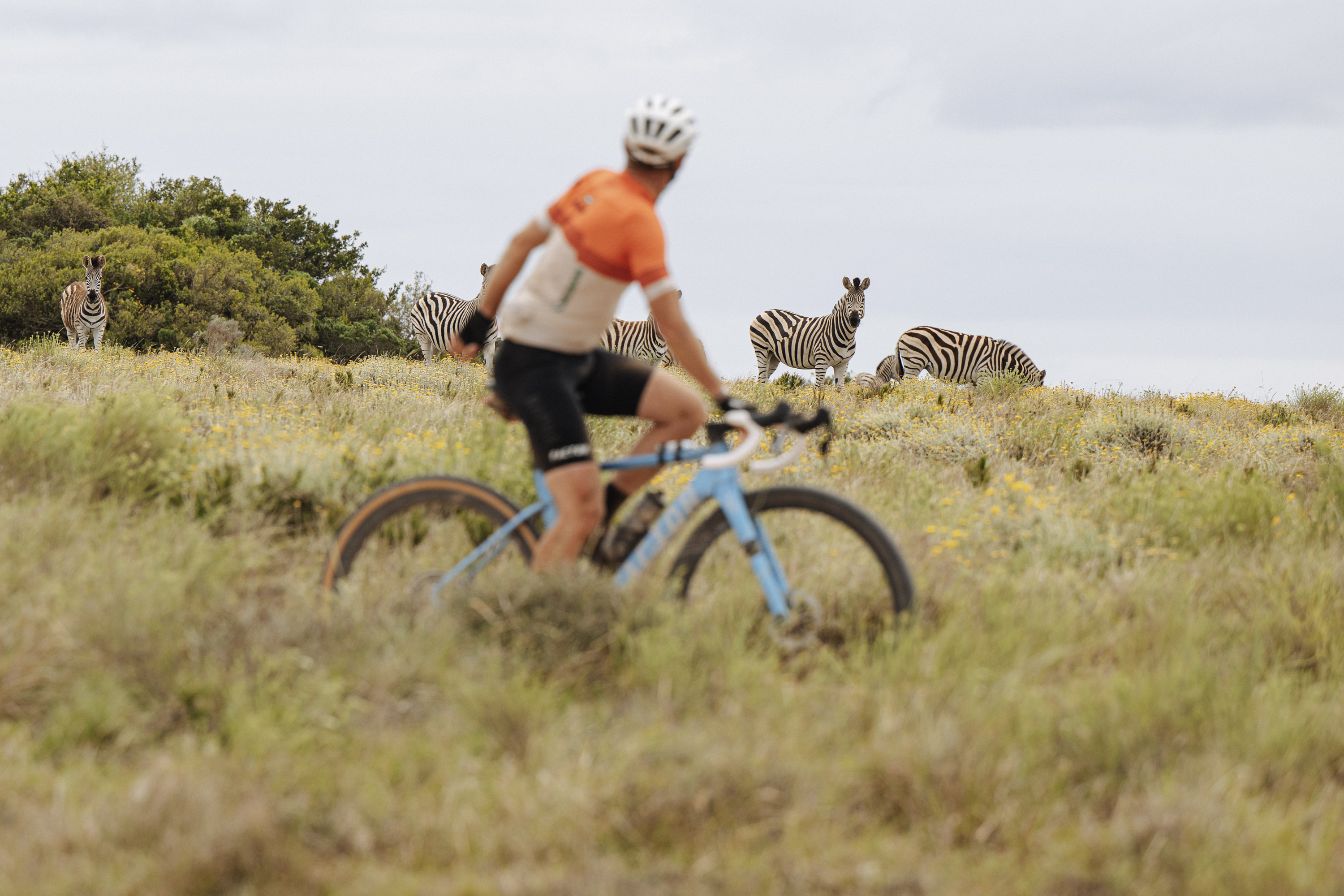
Exotic animals were on display in the latter stages. This included sightings of rhino, giraffe, ostrich, zebra and antelope
The Gravel Burn race director decided to neutralise the first 45km, at which time we'd be notified of any further changes. While the wind did die down momentarily, it intensified an hour later as we reached the first technical descent. The crosswind gusts were so severe that it required you to lean your entire body weight to the side to stay upright, and even that didn't guarantee safe passage. Some riders got blown off their bikes, others, including Andri Frischknecht, had a fall that culminated in a broken collarbone and a suspected concussion. It was at this point that the organisers decided to neutralise the stage: no time would be added to the GC, and riders could get to the finish safely at their own pace.
The next 100km were a lesson in resilience and mental fortitude because what we experienced will be spoken about for years to come and go down as one of the strangest yet eventful days I've had on a bike. We had super-strong winds, rain, heat, hailstones the size of marbles and then more rain and wind. All the weather in one day on one of the most challenging stages of the race – a stage that would have shaken up the GC across all categories, given the mountain bike-like terrain and brutally long descents.
Stage 7 felt easier than stages 4, 5 and 6, but it was also faster with riders gassing it from the start. I found myself in the leading bunch of age groupers and was well positioned for a good result on the stage before another puncture thwarted progress just two hours in, after a fourth river crossing. Coincidentally, I bumped into Peter Stetina again – the American suffering another untimely puncture, one of many during the race, but he still managed to give me a few hits of his C02 catridge to get me rolling again. It was a day of nursing equipment, taking in the scenery of the Shamwari Game Reserve and riding with friends made during the previous stages. We saw some giraffes, zebras and rhinos and wound it up a bit as we entered the final 10km. I found myself in a group that included Lachlan Morton, Peter Stetina, and a few other age-groupers just off the leading pack. We all had the same thoughts, the same sense of relief and understanding that we were riding bikes in a special place packed with beauty, but also surroundings that show no mercy. You need to respect the land, its flora and fauna, or face the consequences.
Africa is not for sissies.
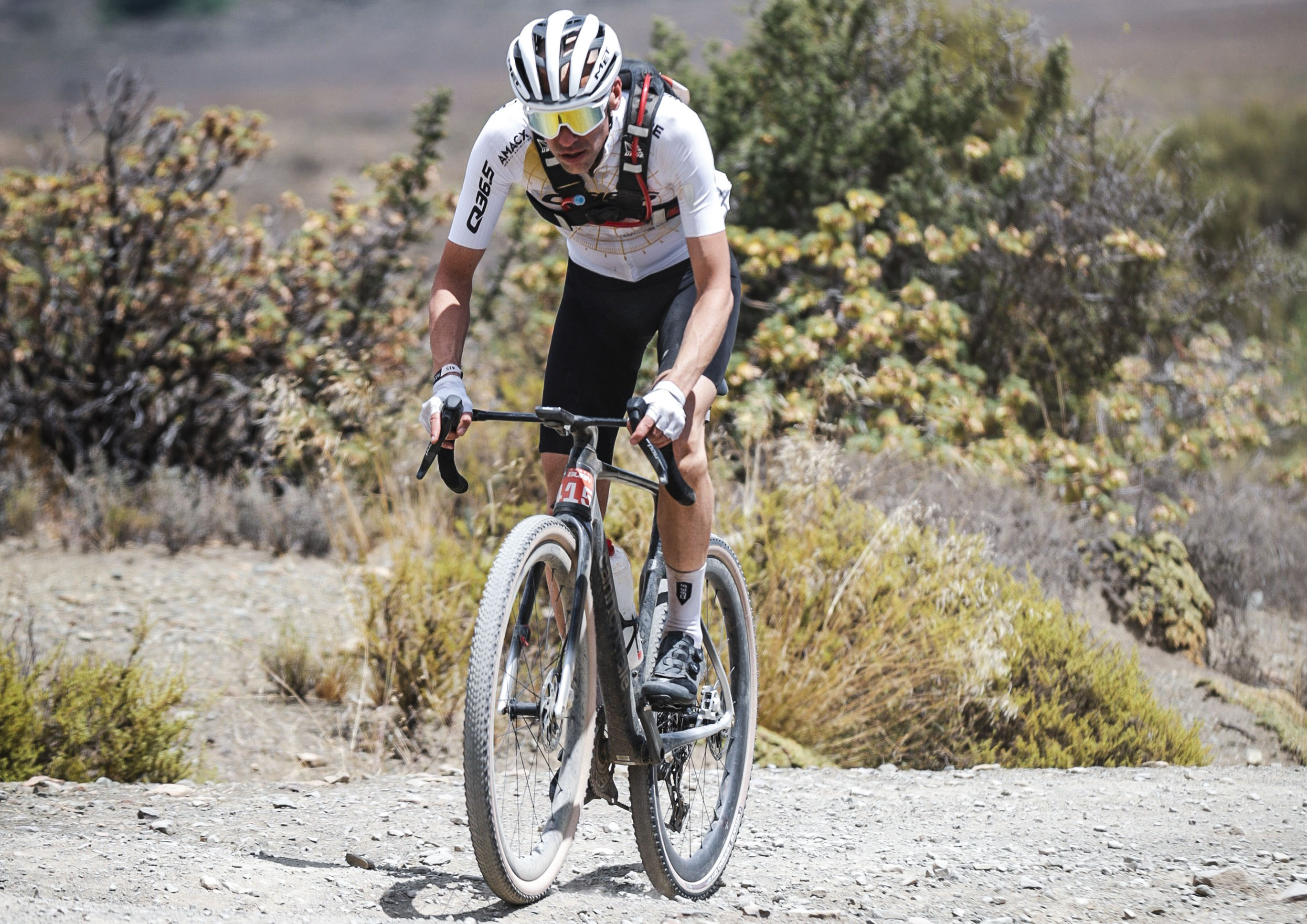
Author Aaron Borrill in full flight on Stage 4 in Blaauwater
No expectations, no regrets
There’s only so much ‘gravel’ preparation you can do in the UK and most of it pales in comparison to what you’ll find on the southern tip of Africa. And I think the lack of technical riding during my preparations showed some flaws in my training – after all, there are few places in the world where you can mimic the kind of trail hostility that played on repeat over the 800km race. While I felt good and had some great days on the bike, I felt out of my depth on the super-sketchy technical descents, where I had to work harder to stay in contact with the sharp end of my category.
I had to get strategic, but also toughen up. I was racing against the best age-group riders in the world, including former professionals and WorldTour road riders. It’s hard to explain the kind of stuff we rode our gravel bikes over and down, but let me try to paint a picture here for you – imagine doing parts of the Cape Epic on a gravel bike. That’s what it felt like. Not on every stage, of course, but as I mentioned above, stages 4-7 were super-tough on the body and bike, and this is where the deep internal conversations and questions start to materialise.
The corrugations were endless. Americans call this terrain a washboard, a road with ripples or grooves. I was envious of those who had opted to fit their bikes with suspension forks. Perhaps my bike was too racy for this event, too road-bike-like, but it got me to the finish line in a respectable position overall.
How did I do? Apart from a third-place finish on stage 3, I came home in 5th place in my category and 45th overall on the GC, ahead of some professional riders. While it would have been mega to snatch a podium spot in my category and sneak into the top 40, given the added stress of working as a journalist at the event, I'll take the result.
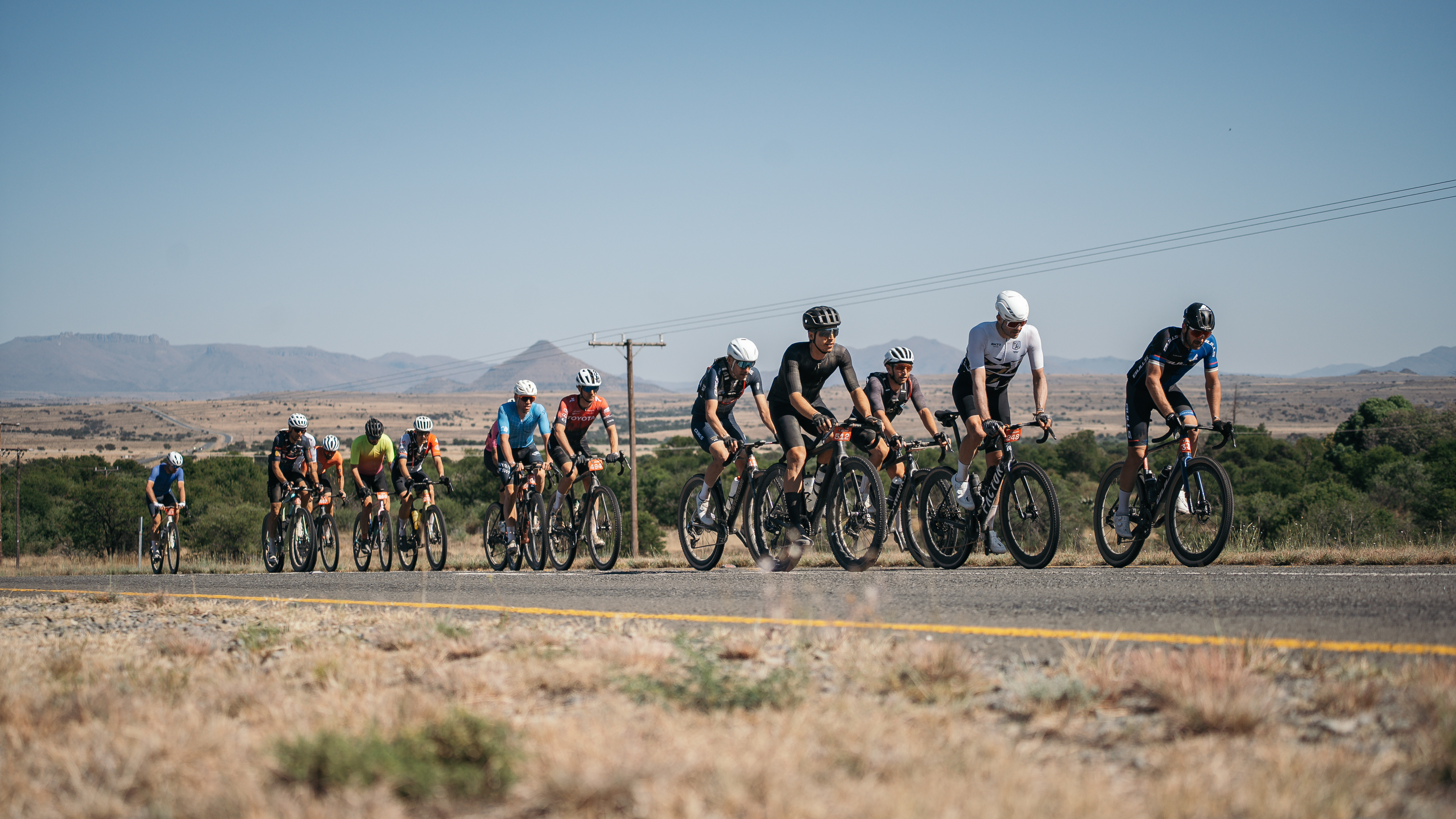
A rare patch of tarmac provided some relief for the aching bodies
Next year's race and the future of Gravel Burn
Should the Gravel Burn organisers dumb it down and grade the roads for future editions? No, that would take away from what this race is all about – overcoming adversity and pushing through to find solutions. Searching for the racing line, snaking across the road in search of smooth gravel, and scanning a few hundred metres ahead to ensure you have enough time to adapt to the constantly evolving surfaces make this as much a sensory experience as a physical one. Sensory overload, in fact. That's what makes the race so special, so beautiful, and so challenging. I don't think this is going to put off any riders from entering in 2026; if anything, I reckon it’s going to attract gravel acolytes wanting to test their mettle to the absolute maximum in their droves.
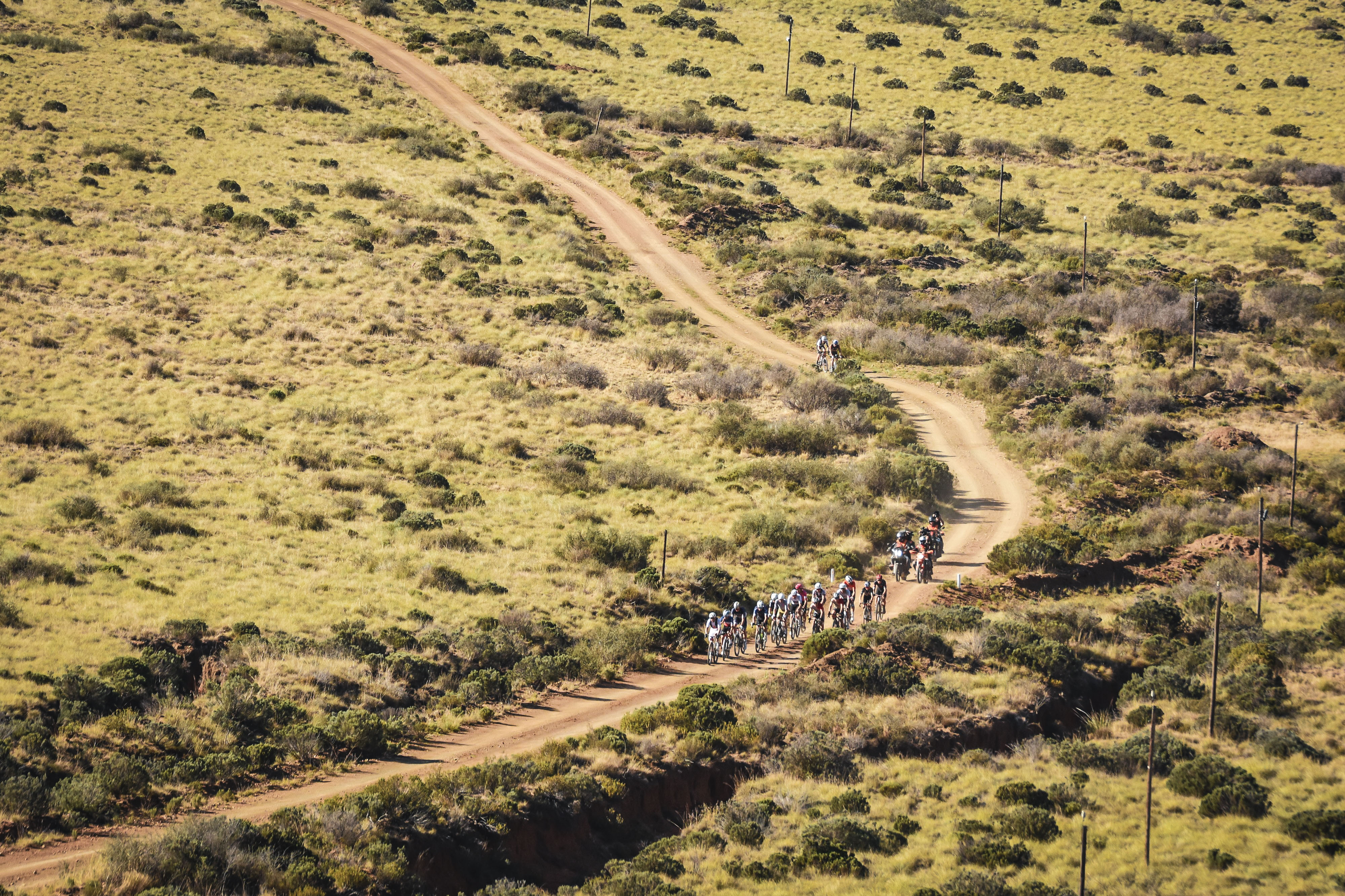
African gravel in all its glory...
During the week, I was having deep internal conversations with myself. Why am I here? Why did I sign up for this? Only to reminisce on my flight back home to the UK about the absolutely incredible seven days of flat-out racing and camaraderie I had shared with old friends and new ones, too. I swore to myself I’d never return, but somehow find myself wanting more – the pain, torment and mental anguish I endured have quickly been forgotten, but then I look in the mirror and see the sunburned skin and blisters on my lips, and I start those conversations with myself again.
Will I be back? Absolutely. Do I want more? Hell, yeah. Have I started looking at new bike setups? You know it.
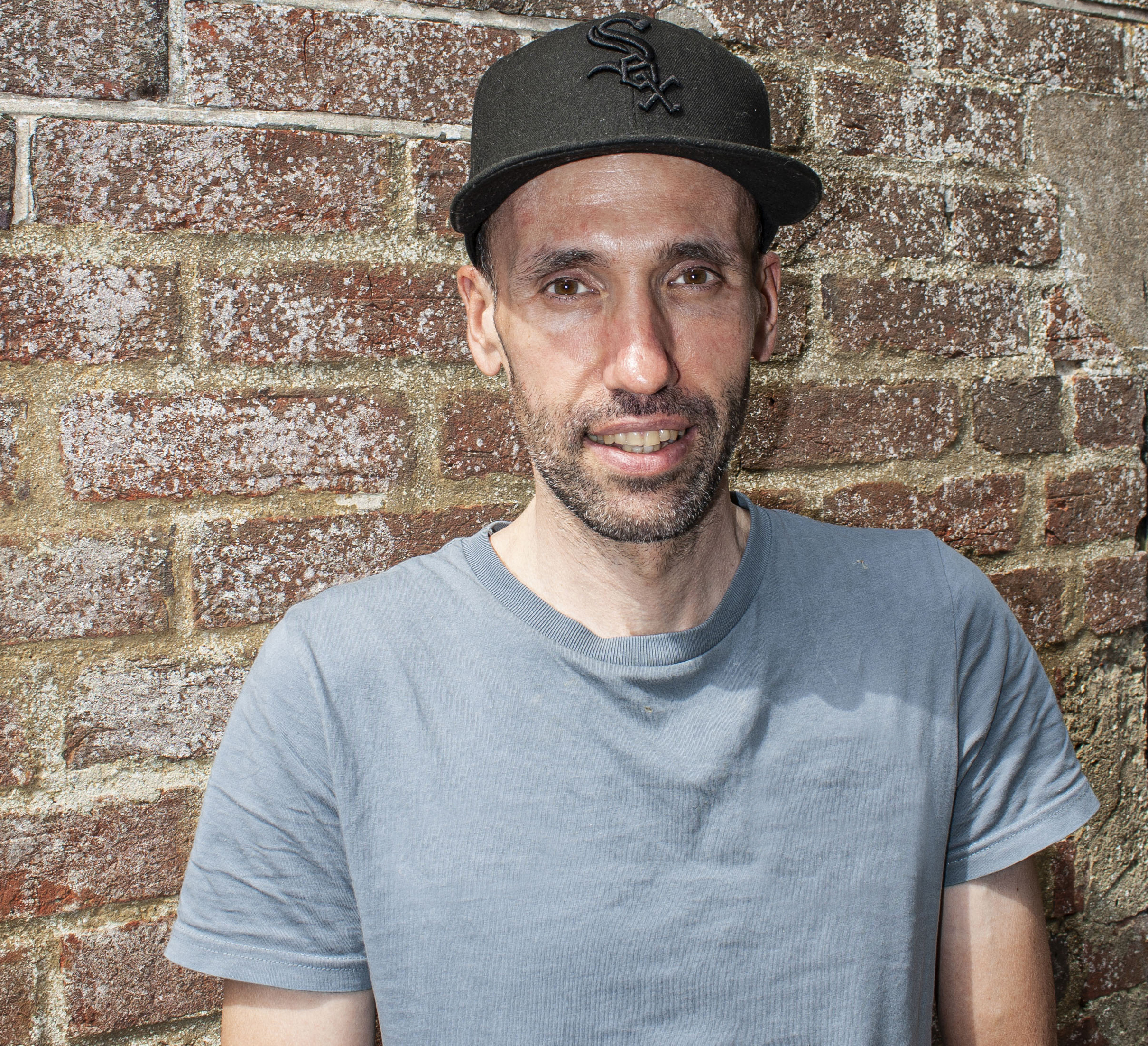
Aaron is Cycling Weekly's tech writer. As the former editor of off.roadcc, tech editor of Cyclingnews and Bike Perfect, digital editor of Bicycling magazine and associate editor of TopCar, he's travelled the world writing about bikes and anything with wheels for the past 20 years. As a racer, he's completed stage races such as the Cape Epic, Berg and Bush, W2W, and Gravel Burn. On the road, he’s completed the Haute Route Alps, represented South Africa at the UCI Gran Fondo World Championships Road Race and Time Trial and is an accomplished eSports racer, too - having captained South Africa at the 2022, 2023 and 2024 UCI Cycling eSports World Championships.
You must confirm your public display name before commenting
Please logout and then login again, you will then be prompted to enter your display name.